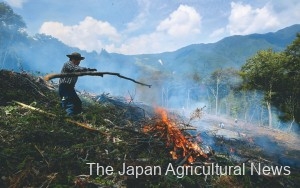MIYAZAKI, Sept. 4 — A variety of agriculture and forestry practices that make use of woodlands and mountain slopes have been handed down for generations in the three towns and two villages of the Takachihogo and Shiibayama areas in Miyazaki Prefecture, located in the middle of the Kyushu Mountains in southern Japan.
The local people have established a sustainable system of agriculture and forestry to coexist with the mountains, including the traditional field burning in the village of Shiiba. The system was designated as a Globally Important Agricultural Heritage System (GIAHS) by the Food and Agricultural Organization of the United Nations in 2015.
On Aug. 16, a fire was lit on a mountain in the village of Shiiba owned by Masaru Shiiba, 70, to start field burning.
The fire lighting was postponed again and again for more than 10 days due to a typhoon and heavy rain, and finally took place after the Bon holidays.
After sacred sake and a chant were offered to the mountain god, a fire was lit on a pile of branches.
Flames and smoke rose up, and the crackling sound of burning bamboo branches echoed in the mountain. The area was engulfed with hot air as the fire raged on.
The location of mountain slopes where field burning is conducted changes every year. The slopes are burned to create arable land where buckwheat seeds are sown, and the crop is rotated with millets and soybeans.
Ashes improve the soil and also have insect pest control effects.
The locals can gain food by burning slopes, engage in forestry in a long term and upgrade the mountain in a cycle of 20 to 30 years.
It is an outstanding composite of agriculture and forestry which turns steep slopes into mountains full of treasure, providing food and resources.
Besides engaging in agriculture and forestry, Shiiba runs an inn.
His mother Kuniko, who died at the age of 99 in June, had been well known as a person who preserved the field burning method and native seeds.
“I believe my mother purely enjoyed burning fields and sowing seeds, rather than thinking she must succeed field burning,” Shiiba said. “I’m sure she must be happy to see today’s fire lighting.”
Shiiba had been the only person conducting field burning in the village, but the momentum to pass on the tradition heightened following the GIAHS recognition and it is currently conducted at three locations.
Nearly 40 people, including neighbors and those from within and outside the prefecture, gathered at the event under the spirit of “kateri,” meaning mutual help in the local dialect.
A feast was held following the event, and surprisingly, around half of the attendants were people in their 20s to 40s who had moved in to the area.
Ayaka Shiiba, 42, moved in from Aichi Prefecture seven years ago, married to a villager and had a child.
“I had never heard of field burning before (I moved here),” she said. “The time spent in the village and its customs are all unique and it is interesting to get to know something I don’t understand. Everyone is like a family here and I feel comfortable.”
The Takachihogo-Shiibayama mountainous area agriculture and forestry composite system, in which people lead lives by utilizing features of agriculture, forestry, livestock farming and mountains, may appear inefficient as they don’t focus on one business. But as a matter of fact, the system works to hedge against risks.
The lifestyle of respecting nature and combining different tasks creates comfort.
Masaru Shiiba’s motto is “issyo hyakusyo” meaning one field burning awakens a hundred lives. This spirit may be what instinctively attracts young people to the village.


